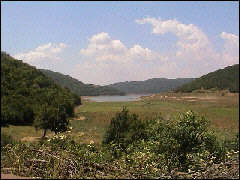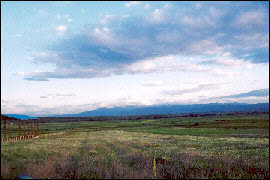 GEOGRAPHY AND ENVIROMENT GEOGRAPHY AND ENVIROMENT |
Kosovo is a country that lies in the heart of the Balkans and is situated in the southwestern part of the Balkan Peninsula. Kosovo borders with Serbia, the FYR of Macedonia, Montenegro and Albania. Kosovo covers 4.25% of the southeastern area of the former Yugoslavia. The administrative territory of Kosovo has a surface area of approximately 10.908 km2 that supports a population of 2.3 million. 90% of this population is Kosovar Albanian and located in 1.438 urban and rural localities.

Typical village in Kosovo
Kosovo is a beautiful land that use to boast a developed and popular tourist industry in the former Yugoslavia. The topography of the land is dramatic and varied from the Great Central "Dukagjini" Plain to the formidable Sar Mountain region in the South.
In the past, tourism was based around visiting the different regions and their outstanding historical cities such as Prizren, Peja and Gjakova or by recreational activities such as skiing in Brezovica, situated in the South of Kosovo. Due to the conflict in 1999 most towns and cities in Kosovo suffered terrible damage and are still in stages of re-development, however over the last few years many improvements have been carried out on hotels, public transport services and recreational facilities.
Kosovo´s suitable geographic position in the Balkan Peninsula reflects in its polyvalent function towards internal natural directions in the Balkans. Kosovo lies at a crossroads and has connections throughout the Balkans as well as between Europe, Asia and particularly with the Middle East. Its economic connections between different countries relate to important historical routes that existed in the region in the past. There are two natural routes that exist and meet near the capital Prishtina, the first connects the North with the South (Belgrade 360km, Skopje 86km, Thessaloniki 360km), and the second connects the East with the West (Sofia 270km, Istanbul 860km.) Shengjini (Gjiri) is situated 270km from Kosovo, Durres is 350km and the Adriatic Coast is situated 208 km away from Prizren.
 ENVIRONMENTAL INFORMATION ENVIRONMENTAL INFORMATION |
Kosova presents a geographically heterogeneous space. Depression zones account for around 36.5 % of the total surface area, and two plains can be distinguished. One in particular is the Kosova Plain that lays from Mitrovica to Kacanik, with an approximate height of 550 meters, it contains the river valley's Llab, Kriva Reka, Ibri and Morava e Eperme. Around 37% of Kosovo's surface area is covered by mountains. In the west we see the Bjeshket e Nemuna mountains (also known as the cursed-summer mountains) its highest peak being Gjeravica with an altitude of 2.656m. In the southwest we find the Sar mountain range, whose highest peak is Bistra with an altitude of 2.640m. In the south one can find the Karadaku I shkupit range with an altitude of 1.650m. In the north there are the Malet e Argjendit, Monte Argentarium (Silver Mountains) that measure up to 1.850m. Between the Kosova and Dukagjini Plain there is a hill terrain that divides these two pools. When one looks at the geographical make-up of Kosovo it appears to be surrounded from four sides.
The Sar and Bjeshket e Nemuna ranges contain snow-capped mountains that can be seen for approximately 8 months of the year. During winter months recreational and sportive tourism take place there. The Sar Mountains boast the largest and only ski center in Kosovo called Brezovica, with ski areas and conditions suitable for most categories. It was built with the technical infrastructure to support many winter recreational and hunting activities. At present however the resort is not operational due to ethnic disputes in the area. The Bjeshket e Nemuna area has different but not so varied ski slopes. According to estimations, these two-ski zones have the capacity to support around 240,000 people skiing at any given time. In the former Yugoslavia these two areas accounted for 1/3 of all ex-Yugoslavias skiing terrain.
| Rivers also compliment the heterogeneous geographical structure of Kosova. The rivers Lumbardh, Drini I Bardhe, Lepenci, Sitnica, Lumbardhi I Pejes, I Decanit, I Prizrenit, all start in Kosovo and end at the Adriatic Sea, while Ibri and Sitnica drain into Black Sea.

Artificial lake central Kosovo
Many artificial lakes were created after World War II. The most popular lakes can be found at Gazivoda, near Mitrovica, and Batllava and Gracanka near Prishtina. They were built to fulfil the water needs of towns, arable lands, and electricity plants such as Obilic near Prishtina. They also serve for local tourism and recreational activities for urban populations in the summer, the most popular lake being Batllava. All rivers and lakes in Kosova are rich with fish, trout being the most common. Fishing is a popular recreational activity amongst the younger, as well as older generations.
Flora and fauna in Kosovo also represents a wealth of natural species. Beech trees, oak, pine and in one area near Decan chestnut-trees are common in forested areas. In spring and summer months the vast plains of Kosovo hold host to an array of wild flowers that carry their scent through the wind. Whilst the mountains with their peaks and troughs are rich with wild animals and birds, such as wild cat (lynx), dark gray bears, Roe deer, mountain chicken, partridge and wild rabbits.
Kosova has a complex geological structure with magmata, sedimentary and metamorphic rocks from all geological periods. Mineral layers have been known about for over 2.000 years. Illyrians, Celts and the Romans have all mined lead and silver here. When Kosova was a part of Yugoslavia it had the largest mineral deposits in all of Europe, that consisted of; 38% coal, 56% lead and zinc, 47% magnesium and 50% nickel. Trepca that is situated near Mitrovica is one of the largest lead and zinc mines in the world, while the biggest reserves of lignite (brown coal) can be found near Prishtina. Lignite deposits are excavated and processed for electricity at Obilic Kosovo's Electricity Station, which used to be the largest plant in all of ex-Yugoslavia.
 CLIMATE CLIMATE |

The Duckajini Plain
The general weather pattern in Kosovo has extreme variations. The weather in this region is very unpredictable due to regional topography and geographical positioning. Weather conditions vary from severe winter continental conditions to moderate Mediterranean temperatures during spring and summer months. Kosovo experiences very cold winters, heavy snow and temperatures that can plunge below -30 Celsius. Summertime however in general experiences temperatures that exceed 30-35 degrees Celsius. Sudden downpours and frequent thunderstorms are common in summer months, which settle the dust in the more built up and areas of Kosovo. The best time to visit Kosovo is in late spring when the temperature is most comfortable. |

